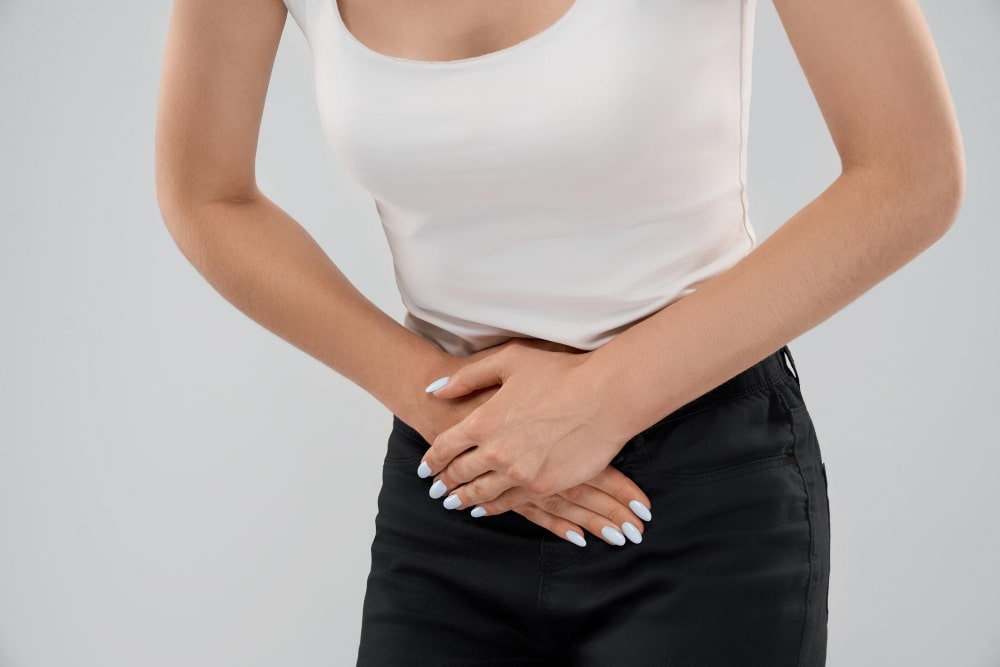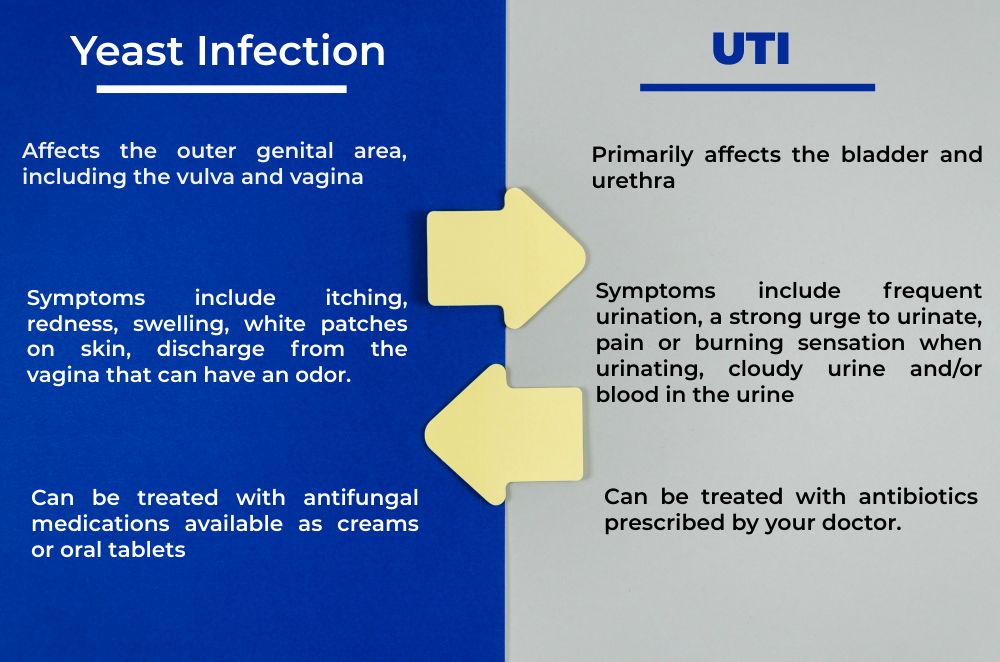Yeast infections and urinary tract infections (UTIs) are two common types of infections that require treatment. Although they have similarities, these two conditions may seem quite different. For one, although yeast is a type of bacteria, UTIs are generally caused by other bacteria, such as Escherichia coli (E. coli). Additionally, the symptoms associated with both infections can vary significantly. This article will explore can a yeast infection cause a uti, the potential connection between yeast infections and UTIs, the signs of each infection, treatments, and prevention strategies. This information may help you better understand your risk for developing either of these infections or both simultaneously.
Understanding Yeast Infections and UTIs
What is a Yeast Infection?
A yeast infection known as candidiasis is an overgrowth of a fungus called Candida. This infection can occur in many body areas, including the vagina, mouth, and skin. Women are far more likely to experience these infections due to changes in their hormone levels throughout life.
What is a UTI?
A UTI occurs when bacteria enter the urinary tract and bladder. This infection is most commonly caused by E. coli, a bacteria found in the digestive system. However, other organisms, including fungi, can also cause UTIs.
How Are They Different?
Yeast infections and UTIs are typically caused by different types of microorganisms. Additionally, yeast infections mostly affect women, while anyone can develop a UTI. Furthermore, the treatments for each infection are different.


Read More: Best Cranberry Juice for UTI: Remedy for Urinary Tract Infection
Can a Yeast Infection Cause a UTI?
The connection between these two conditions must better understand and clarified in medical research. So far, there is no definitive answer on whether a yeast infection can directly cause a UTI.
The Connection Between Yeast Infections and UTIs
Some studies have suggested that a yeast infection may increase your risk of developing a UTI, as the presence of fungi can create an environment for bacteria to flourish. This is because Candida species are known to interact with other microorganisms like E. coli in the urinary tract.
Risk Factors for Developing Both Infections
Certain risk factors increase your chances of developing a yeast infection or UTI. For instance, women are more likely to experience yeast infections due to hormonal fluctuations and anatomical differences. Additionally, people with weakened immune systems or diabetes are at higher risk for both infections.
Medical Studies and Findings
Research on the relationship between UTIs and yeast infections is limited. Some studies suggest that certain Candida species can make it easier for E. coli and other bacteria to attach to cells in the urinary tract, thereby increasing the risk of infection.
Read More: Sciatic Nerve Pain Relief at Night: How to Relief It?
Symptoms of Yeast Infection and UTI
Yeast Infection Symptoms
Yeast infections can cause itching, burning, and swelling in the affected area. Other symptoms include pain while having sex or urinating, a thick white discharge that looks like cottage cheese, redness, soreness, and rash-like patches on the skin.
UTI Symptoms
UTIs may cause a frequent urge to urinate even when there is no urine to pass, a burning sensation, cloudy or foul-smelling urine, pressure in the lower abdomen and pelvic area, fatigue, fever, and chills.
Overlapping Symptoms
Both yeast infections and UTI can cause pain while urinating or having sex. Additionally, both conditions may involve vaginal discharge. However, this discharge may look and smell differently depending on the type of infection.
Read More: Sharp Pain Behind Eye: What Causes It, How to Relief
Treating Yeast Infections and UTIs
Yeast Infection Treatments
Treatment for yeast infections usually involves antifungal medications that can take orally or applied directly to the affected area. Additionally, natural remedies like garlic capsules have been found to reduce symptoms.
UTI Treatments
UTIs are usually treated with antibiotics, depending on the type of bacteria causing the infection. However, if left untreated, a UTI can lead to more serious complications, including kidney damage and sepsis.
Considerations for Simultaneous Infections
If you have both a yeast infection and a UTI, your doctor may recommend treating both conditions at the same time. Additionally, they may suggest reducing the risk of future infections, such as drinking plenty of fluids and avoiding douching or using perfumed feminine products.
Read More: Sharp Pain in Big Toe: Causes, Symptoms, and Treatment Options
Prevention Strategies
Preventing Yeast Infections
To prevent yeast infections, you should practice good hygiene by taking regular showers, avoiding tight-fitting clothing, and keeping the genital area dry. Additionally, you should avoid scented products such as tampons or sanitary napkins, as they can disrupt your pH levels and lead to an infection.
Preventing UTIs
To reduce your risk of developing a UTI, you should drink plenty of fluids, practice good hygiene, empty your bladder after sexual intercourse, and wear cotton underwear. Additionally, it is important to wipe from front to back when using the bathroom.
Lifestyle Changes for Better Health
Making lifestyle changes can help reduce your risk of yeast infections and UTIs. Eating a balanced diet, avoiding processed foods, exercising regularly, getting enough sleep, and managing stress are all important factors in maintaining good health. Additionally, it is important to keep your immune system strong by taking vitamin supplements and eating probiotic-rich foods such as yoghurt or kimchi.
Read More: Elbow Pain When Lifting: What Causes It, How to Treat It?
Seeking Medical Advice
If you experience any yeast infection or UTI symptoms, it is important to seek medical attention as soon as possible. Your doctor will be able to properly diagnose and treat your condition with the right medications and lifestyle modifications. Additionally, they may suggest additional tests to evaluate whether you have one infection or both simultaneously. Keeping up with preventive measures can help reduce your risk of recurrent infections.
Tips for Self-Care:
Steps to follow when dealing with a yeast infection or UTI
- Practice good hygiene and keep the affected area clean and dry
- Wear loose, breathable clothing and cotton underwear
- Take probiotic supplements and eat foods that are rich in probiotics
- Drink plenty of fluids such as water, cranberry juice, or herbal tea
- Avoid douching or using scented products
- Empty your bladder after sexual intercourse
- Avoid processed foods and opt for a balanced diet
- Exercise regularly and manage stress levels to strengthen your immune system
- See a doctor if you experience yeast infection or UTI symptoms.
By following these tips, you can help reduce your risk of developing recurrent infections and maintain better overall health. Remember to always consult your doctor before starting any new treatments or making lifestyle changes.
Read More: How to Relieve Hip Pain While Sleeping: Best Sleeping Ideas
Conclusion
In conclusion, it is important to be aware of the possible relationship between yeast infections and UTIs to take preventive measures. Practising good hygiene, eating a balanced diet, getting enough exercise and sleep, and seeking medical help whenever needed are all important steps to simultaneously reduce your risk of developing either infection or both. Self-care practices can also be beneficial in managing symptoms and promoting better overall health. However, always consult your doctor before making any lifestyle changes or starting new treatments.
FAQs
Yes, it is possible to have both a yeast infection and a UTI at the same time. In this case, your doctor may recommend treating both conditions simultaneously.
Yes, a yeast infection can lead to a UTI. This is because the imbalance of bacteria in your vagina caused by the yeast infection can make it easier for the bacteria that cause UTI to take hold and grow, leading to a urinary tract infection.
It is not recommended to attempt to diagnose or self-treat a yeast infection or UTI at home. Instead, it is best to visit your doctor as soon as possible for them to diagnose and treat the condition with the right medications properly. Additionally, your doctor may suggest additional tests to evaluate whether you have one infection or both simultaneously.
Common treatments for a yeast infection include antifungal medications, such as pills, creams, suppositories, and ointments, which can usually purchase over the counter at your local pharmacy. For UTIs, prescription antibiotics are typically used to treat the infection.
The main difference between a yeast infection and UTI is the type of bacteria causing the infection. A yeast infection occurs when there is an overgrowth of the fungus Candida albicans in the vagina, while a UTI is caused by bacteria entering and infecting the urinary tract. Although both conditions can cause similar symptoms, such as pain or burning while urinating and vaginal discharge, these will usually appear differently depending on your infection. Additionally, yeast infections typically occur more often than UTIs.

